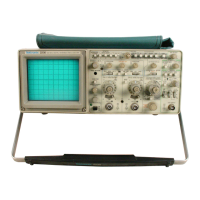Operating Information—2230 Service
enough that the acquisition can manually be
stopped when events of interest are observed.
P-P AUTO is selected. P-P AUTO provides a
baseline in the absence of triggers from the
input signal. The circuit considers the absence
of triggers to be about half of a second without
a trigger. Below 50 ms per division, the
triggers are prevented for longer than that by
the sweep time itself, therefore triggers are
ignored.
TRIGGERED mode performs triggered acquisi
tions in STORE mode at SEC/DIV settings of 5 s
per division to 0.1 s per division when triggers
can be meaningful. Triggers are meaningful in
SCAN mode if the A TRIGGER mode is NORM or
SGL SWP. Triggers are not meaningful in ROLL
mode or in the A TRIGGER Mode of P-P AUTO.
REPETITIVE Store mode (2 ps/div to 0.05 MS/div)
requires a repetitive trigger signal. Sampling
occurs at the maximum A/D conversion rate. If a
control affecting an acquisition parameter or func
tion is changed, the acquisition is reset, and the
waveform being acquired is cleared on the next
sample acquired. On each valid trigger, 10 or
more equally spaced samples are acquired and
displayed on the waveform record, depending on
the SEC/DIV setting (see Table 2-3). The random
time delay from the trigger to the following sam
ple clock transition is measured by the Clock
Delay Timer circuit and used to place the acquired
waveform samples in the correct display memory
location. Any display location is equally likely to
be filled. Table 2-3 gives the statistically expected
number of trigger events required to completely
fill the display, assuming a uniform distribution of
trigger events relative to the sample interval.
FAST RECORD Storage mode (5 MS/div to
10 ns/div) updates a full record of the acquired
waveform.
SLOW RECORD Storage mode (20 MS/div to
50 ms/div) updates a full record of the acquired
waveform.
SCAN Storage mode (for NORM TRIGGER mode
and 0.1 s/div to 5 s/div or EXT CLOCK) updates
pretrigger data when a trigger is received. The
waveform display then scans to the right from the
trigger point to finish the post-trigger acquisition
and then freezes.
SCAN Storage mode (for P-P AUTO TRIGGER
mode with auto triggers disabled and 0.1 s/div to
5 s/div or EXT CLOCK) continuously updates the
display serially as each data point is acquired. It
writes over previous data from left to right.
ROLL Storage mode (P-P AUTO TRIGGER mode
and 0.1 s/div to 5 s/div or EXT CLOCK) continu
ously acquires and displays signals. Triggers are
disabled. The waveform display scrolls from right
to left across the crt with the latest samples
appearing at the right edge of the crt.
SCAN-ROLL-SCAN Storage mode (SGL SWP
TRIGGER mode and 0.1 s/div to 5 s/div or EXT
CLOCK) serially updates the display. The
waveform display SCANS left to right until the
pretrigger record is filled, and then ROLLS right
to left until a trigger is received. It then SCANS
left to right again to fill the post-trigger acquisition
record and then freezes (see SGL SWP descrip
tion for further details).
PEAKDET Acquisition mode digitizes and stores,
in acquisition memory as a data pair, the
minimum and maximum levels of the input signal
within the time represented by 1/50 of a division
UN-MAG (1/25 division in CHOP or ALT).
SAMPLE samples the signal at a rate that pro
duces 100 samples per graticule division. In the
RECORD Sampling modes, the displayed sample
points are displayed by vectors or dots. For
REPETITIVE Store mode, the sample points are
displayed as dots.
Table 2-3
Repetitive Store Sampling Data Acquisition
SEC/DIV
Switch
Setting
Samples Per
Acquisition
Expected
Acquisitions
Per Waveform*
IK
Mode
4K
Mode
1
Channel
2
Channels
0.05 ps
10 40
519
450
0.1 it s
20
80 225 191
0.2 ms
40 160
96
83
0.5 ms
100 400 30 23
1 MS
200 800
12
11
2 MS
200
800 12
1.1
'Expected acquisitions per waveform for a 50% probability of
fill.
2-10

